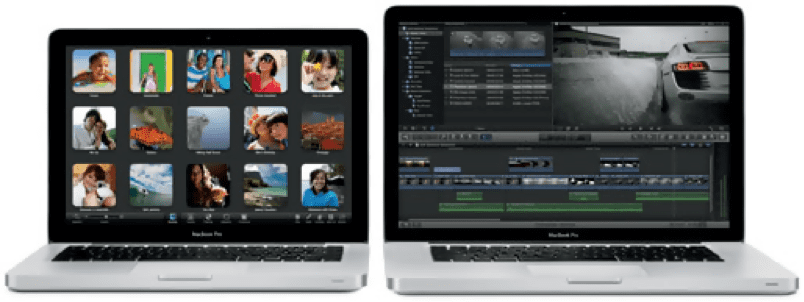It is important to take note that the company doesn’t sell “Early 2013” MacBook Pro versions in the market. For this reason, we updated this Q&A with useful information which you can utilize for buying or selling one of these models that are still part of the used market up to this day.
Apple published a press release noting that the “Early 2013” MacBook Pro models, such as the stock configurations of MacBook Pro “Core i7” 2.3 15”, “Core i5” 2.6 13” and “Core i7” 2.7 15” feature updated processors which are faster and way more affordable compared to the “Mid 2012” and 13-Inch “Late 2012” predecessors. There was a time when the company dropped the price tag of the MacBook Pro “Core i5” 2.5 13” from the “Late 2012” but continued to offer new models in the line of the “Early 2013” units.
Based on available promotional materials, the company took an effort to highlight the difference in the performance of the flash storage-equipped Retina Display MacBook Pro and the “pre-Retina” MacBook Pro versions with a slower hard drive which are upgradeable to utilizing fast flash storage too. But, Apple doesn’t compare the “Early 2013” MacBook Pro lines to one another or even the versions replaced immediately or supplemented, which is the case for the units in the 13-Inch systems.
There is only a slight difference between the clock speed and the company’s marketing team opted to not disclose the specific performance improvement of the models. The distinction is almost modest, most especially in the speed of the “Early 2013” MacBook Pro lines and predecessors of the same type. To compare the two models, the 13-Inch lines have dual-core processors and slower integrated graphics while the 15-Inch series come with quad-core processors with faster-dedicated graphics which can be expected from 15-Inch versions that set them apart from their smaller brethren.
If you are curious about the real difference of the said models, there would be a need to benchmark and real-world tests to confirm. To anyone who considers these models, we can compare the performance of the 13-Inch Retina Display MacBook Pro to the “Mid 2012” MacBook Air versions.

Retina Display MacBook Pro 15” Left, 13” Right
General Performance Overview
If you want a solid overview of the “Early 2013” Retina Display MacBook Pro versions, we have an Ultimate Mac Comparison here at Techable for a quick side-by-side comparison of the 32-bit and 64-bit models with other G3 and thousands of possible Mac performance identification.
Everymac did a benchmarking, and it revealed that the MacBookPro “Core i5” 2.6 13” (Early 2013) stock is 3% faster than the older models in “Late 2012” such as the MacBook Pro “Core i5” 2.5 13”. In the same manner, the “Early 2013” MacBook Pro “Core i7” 2.7 15” and “Core i7” 2.3 15” which are 3% and 4% faster than the MacBook “Core i7” 2.6 15” and “Core i7” 2.3 15” that became a replacement for each of the earlier mentioned model.
If you are thinking of a more significant performance difference, there is only a modest development in the “Early 2013” 15-Inch models, specifically the MacBook Pro “Core i7” 2.7 15” which is 7% better than the entry-level, MacBook Pro “Core i7” 2.3 15”.
But, there is a performance difference between the versions 13-Inch and 15-Inch from the “Early 2013” too. And it is substantial. The rate of improvement is way higher than the other lines. For example, the entry-level MacBook Pro “Core i7” 2.3 15”, and the sophisticated MacBook Pro “Core i7” 2.7 15” which are faster by 64% and 76% than the “Core i5” 2.6 13”.
Lastly, the MacBook Pro “Core i5” 2.5 13” (Late 2012) and “Core i5” 2.6 13” (Early 2013) stock are 9.5% to 12% faster than the standard unit, which is the MacBook Air “Core i5” 1.8 13” (Mid 2012).
Other Performance Test Results
It is safe to conclude that there are only minor updates with the “Early 2013” Retina Display MacBook Pro. However, the models did not really attract attention in the blogosphere. Despite the RAM amount and a modestly faster processor, it is obvious that the 15-Inch Retina Display MacBook Pro was only 3% faster than its previous 15-Inch model contemporary in that it shares the same graphics and flash storage. As for the new high-end model, it was only 5% faster than the overall and brand new lines of the Retina series. Compared to the performance of the low-end 15-Inch Retina Display MacBook Pro, and the high-end 13-Inch Retina Display MacBook Pro, the difference is 47% which is larger overall.
Performance Summary
Hence, the 15-Inch “Early 2013” Retina Display MacBook Pro versions are considerably faster than their equivalent 13-Inch lines.
The “Early 2013” Retina Display MacBook Pro version exhibits a slight performance improvement far from the earlier Retina Display MacBook Pro lines either supplemented or repaired. Regardless, it is always possible to add speed to emphasize performance even more. If you are particular about the price of your purchase, it wouldn’t hurt to consider the Retina Display MacBook Pro.
